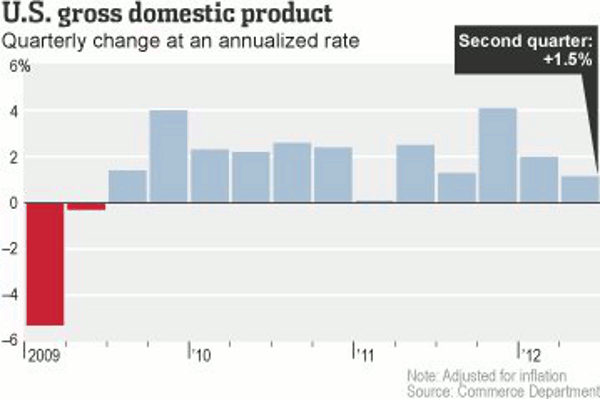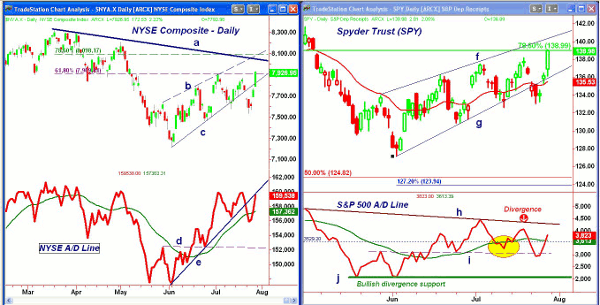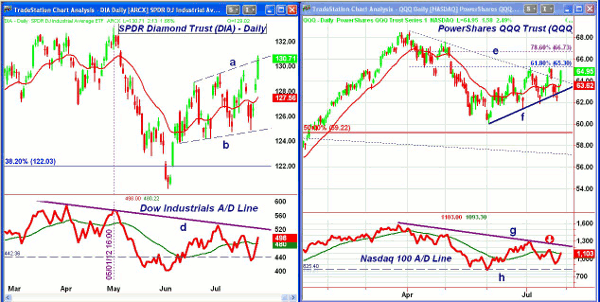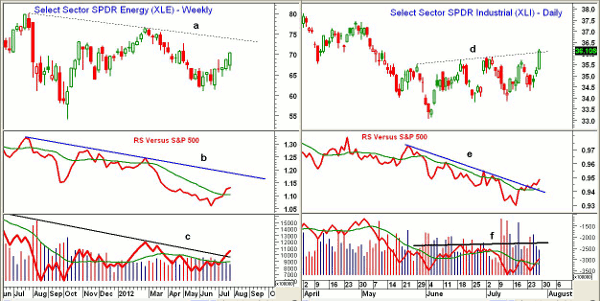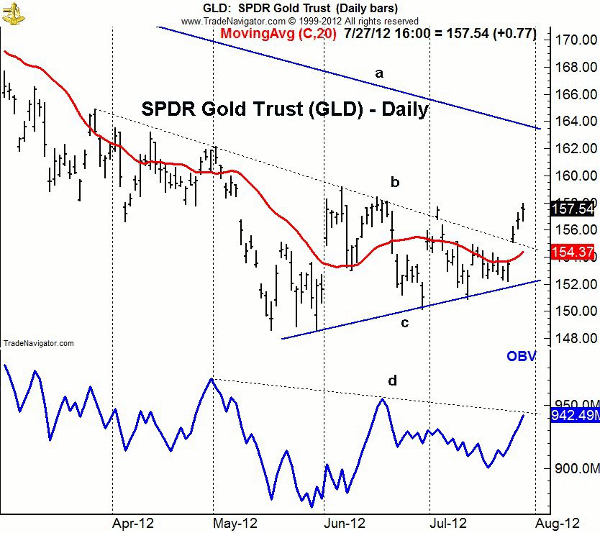All it took was a few words from Europe's top banker to turn stocks around, but can the momentum last? MoneyShow's Tom Aspray shares his near-term outlook and the specific investments that bear watching for savvy investors.
The surprising comments from European Central Bank’s Mario Draghi on Thursday rocked the markets, with the Spyder Trust (SPY) closing up almost 2% for the week, making it the best week for the entire month. The Dow Industrials were able to move above the psychological level of 13,000. Both are now positive for the month.
It was not only stocks. Gold also came to life, as the SPDR Gold Trust (GLD) was also up over 2.5% for the week. The euro, which Draghi promised to defend at all costs, hit a low of 1.2042 on Tuesday, but closed the week at 1.2367.
On Friday, both German Chancellor Angela Merkel and French President François Hollande voiced their support for the euro. Added to Draghi’s comments, it gave global markets another shot in the arm. Further reports Friday afternoon regarding an upcoming meeting between the Draghi and the Bundesbank’s head squueezed those on the short side even more
The dollar has reversed sharply, but the September Dollar Index needs to drop well below 81.50 (the mid-June lows) to complete a top. A weaker dollar would be very supportive for US stock prices.
Many are wondering if this is enough to put a floor under stock prices, and whether the world stock markets have already seen their lows for the summer. This may be the enough to convince some market professionals who have been sitting on the sidelines in fear over an imminent euro collapse.
For the individual investor, I think it will take more reassurance, as most are disillusioned and don’t trust the markets. Sentiment and confidence play an important role in the markets, and I think it will take a period of time (or much lower bond prices) to bring individuals back to the market
I think many will be surprised by this chart. (I was.) It shows that the German Dax has outperformed the Spyder Trust (SPY) by over 2.5% so far in 2012. The Dax surged last week from a low of 6,324 to close at 6,689. It is still below its mid-July high of 6,775.
The Dax was up over 21% in mid-March. Those who have been long the Comex December gold futures are up just 2.7%, which trails the 9.8% gain by SPY.
The economic news last week was mixed. While new home sales were much weaker than expected, the pending home sales last Thursday were not nearly as bad. Then we got the initial reading on second-quarter GDP on Friday, which showed 1.5% growth, slightly better than the 1.3% growth that most expected.
The stock market seemed to ignore the data that indicated it was the lack of consumer spending that was holding the economy back. Exports were fairly strong at 5.5%, and of course will improve much more if the dollar weakens.
The ECB action could be just the first step as they could lower rates this week. The FOMC also meets and one wonders if they will vote in advance to take action if Friday’s monthly job report is weak.The FOMC meets this week, and one wonders if they will vote in advance to take action if Friday’s monthly job report is weak.
There is a full economic calendar this week, as Monday we get the Dallas Fed Manufacturing Survey, followed on Tuesday by the personal income and outlays, S&P Case-Shiller House Price Index, Chicago PMI, and Consumer Confidence. Also, the FOMC meeting starts on Tuesday.
Then on Wednesday, we get the widely watched ADP Employment Report, along with the ISM Manufacturing Index. Of course, the deterioration in past measures of manufacturing activity has concerned the markets for several months.
In addition to jobless claims Thursday, we also get the latest data on factory orders. The ISM non-Manufacturing Index comes out Friday at 10 a.m. EDT and follows the release of the monthly iobs report at 8:30 p.m.
NEXT: What to Watch |pagebreak|
WHAT TO WATCH
By the close of trading last Tuesday, the market internals after three days of heavy selling had dropped below further support. Given the short-term negative divergences that had formed last Friday, this suggested that the market had entered a more difficult phase, as I discussed Wednesday.
The action resolved the debate over "Bear Flag or Bear Trap?" as the Advance/Decline lines had completed their flag formations. Therefore, I was clearly not expecting the stocks to end the week on such a strong note.
The AAII survey of individual investors became a bit more bullish after Thursday’s rally. Over 28% are now bullish, up from 22% the previous week. The financial newsletter writers as of last Wednesday’s close were a bit more negative, but are still too bullish at just over 40%.
On Thursday, I recommended significant changes to the Charts in Play Portfolio, reducing the total equity exposure by about 14%. This was accomplished by recommending the selling of part or all of several positions on Friday’s opening.
Despite Friday’s gains, I am still comfortable with the decision. While the technical picture has clearly improved, there are no strong signs that a new uptrend is underway. The portfolio is still over 50% invested in equities and did quite well Friday.
The NYSE Composite has moved slightly above its previous peak, and is again challenging the 61.8% Fibonacci resistance at 7,909. A close above the downtrend (line a) and the 78.6% Fibonacci retracement resistance at 8,098 is needed to confirm that the market has began a new uptrend.
The cumulative NYSE Advance/Decline line dropped below its uptrend (line e) and the prior lows early last week, but has now turned sharply higher. Despite Friday’s action, it is still below the prior two highs, and a move above the March highs will confirm much higher stock prices.
S&P 500
The Spyder Trust (SPY) exploded to the upside last week, as it overcame the resistance at $138 to $138.50 and tested the 78.6% Fibonacci retracement level at $138.99.
There is further resistance now at $140 and then $142.20, which was the April high. There is additional resistance from 2008 in the $144.40 area.
The SPY held above the key support at $132.60 last week, but the S&P 500 A/D line did not.
The S&P 500 A/D has moved back above its WMA, but is still below the previous highs formed in July. The A/D line needs to close above the bearish divergence downtrend (line h) to signal that a new uptrend is underway.
There is initial support at $135.50 to $136 and then $134.50.
Dow Industrials
The SPDR Diamonds Trust (DIA) broke through the upper boundaries of its flag formation (line a) on Friday, with the Dow moving above 13,000. There is next resistance from the May highs at $131.85 to $133.14.
The Dow Industrials A/D line is still acting weaker than prices. In most healthy rallies, the A/D lines lead prices higher. Though the A/D line is back above its WMA, it is still well below the July high and the major downtrend (line d). This downtrend reflects the negative divergence that formed at the May highs and helped identify the top.
There is first good support now in the $127.60 to $128.80 area with more important levels near $127 to $126.16.
Nasdaq-100
The PowerShares QQQ Trust (QQQ), unlike DIA, did not surpass the previous highs on Friday, though it was sharply higher, adding over 2%. It is still below the recent high and the 61.8% Fibonacci retracement resistance at $65.30. The 78.6% resistance is at $66.73.
- To learn more above Fibonacci analysis, read Fibonacci Analysis: Master the Basics.
The Nasdaq-100 A/D line is also lagging the price action as it closed last Friday just barely above its WMA. It is below its prior peak and the downtrend (line g). As I mentioned last time, it was a concern that the A/D line formed lower highs on the prior rally while prices made higher highs
There is first support now at $64, with the 20-day EMA to follow at $63.60.
NEXT: Russell 2000 |pagebreak|
Russell 2000
The rally in the iShares Russell 2000 Index Fund (IWM) came close to the June lows last week, as it hit $76.22 before reversing to the upside. In late June, the low was $75.42.
The Russell 2000 A/D line (not shown) did improve as IWM moved higher, but has not yet moved back above its WMA. It is still well below the major downtrend that goes back to February. This resistance needs to be overcome for the technical outlook to turn bullish on the small-cap stocks.
IWM has next resistance in the $80 to $80.60 area, and then at $81.84, which was the early July high.
Sector Focus
Even though the iShares Dow Jones Transportation Average Index Fund (IYT) was up close to 3% on Friday, it still is lagging behind the other major averages. A strong close above $94 is needed to improve the outlook. IYT did violate the late June lows on the recent drop.
The Select Sector SPDR Financials (XLF) rose sharply behind large gains in some of the big banks, like Morgan Stanley (MS), up 4.9%, and Citicorp (C), up 4.5%
The Select Sector SPDR Consumer Staples (XLP) made new rally highs on Friday, as did the Select Sector SPDR Utilities (XLU), the Select Sector SPDR Energy (XLE), and the Select Sector SPDR Industrials (XLI).
The weekly analysis on the Select Sector SPDR Energy (XLE) improved last week, suggesting that a major low may be in place. It looks like I was too cautious last week. There is still strong resistance in the $72 to $74 area and the downtrend (line a).
The weekly relative performance or RS analysis has moved back above its WMA, with further resistance at the downtrend (line b). It is also quite positive that the weekly OBV has moved through its long-term downtrend (line c) that goes back to early 2011.
The Select Sector SPDR Industrials closed Friday above the daily chart resistance (line d), with next resistance in the $36.50 to $37 area. There is first support at $35 to $35.50.
The daily relative performance has broken its downtrend (line e), but it has note yet bottomed out. The OBV is lagging the price action, as while it is above its WMA, there is key resistance at line f.
Crude Oil
The September crude-oil contract bounced off the 20-day EMA last week, but still closed the week lower. There is support now at $86.80 to $87.50, which if broken would weaken the outlook. There is next resistance at $92 to $93.25.
Precious Metals
The SPDR Gold Trust (GLD) put in a strong performance last week, gaining 2.8%. The daily chart shows the early July highs have been overcome. A close above the June high at $159.20 would be even more bullish.As I discussed early in the month, in “Gold Glistens in July," there was a high degree of negative sentiment, and gold has a seasonal tendency to bottom in July.
The daily OBV is just below its initial resistance (line d). It would take a move above this resistance and further improvement in the weekly OBV to confirm that a low is in place.
We could see a pullback to the rising 20-day EMA , currently at $154.37 this week.
The Week Ahead
This week should be quite interesting, as we have the FOMC meeting, possible ECB action, and another jobs report. The last two have been pretty bad, and while I would be surprised to see a very positive report, it could light a fire under the stock market.
A more complex bottom pattern may still be forming, as the lagging action of all the Advance/Decline lines is not a healthy sign. Until we get much stronger signals, I am comfortable with 50% commitment to the market and the use of stops that do not allow any position to damage the overall portfolio.
I will continue to look for new stocks, especially in the energy sector, where the risk can be kept under 5%. We were not stopped out of many positions last week, but as you can see from the portfolio page, most of the stops are fairly close to the entry point.
If you are not in the market, probably some type of dollar-cost averaging (if you have low or no commissions) or a DRIP program may be the best, as I would not be surprised to see stocks 8% to 10% higher later this year.
- Don’t forget to read Tom's latest Trading Lesson, Portfolio Pruning 101


